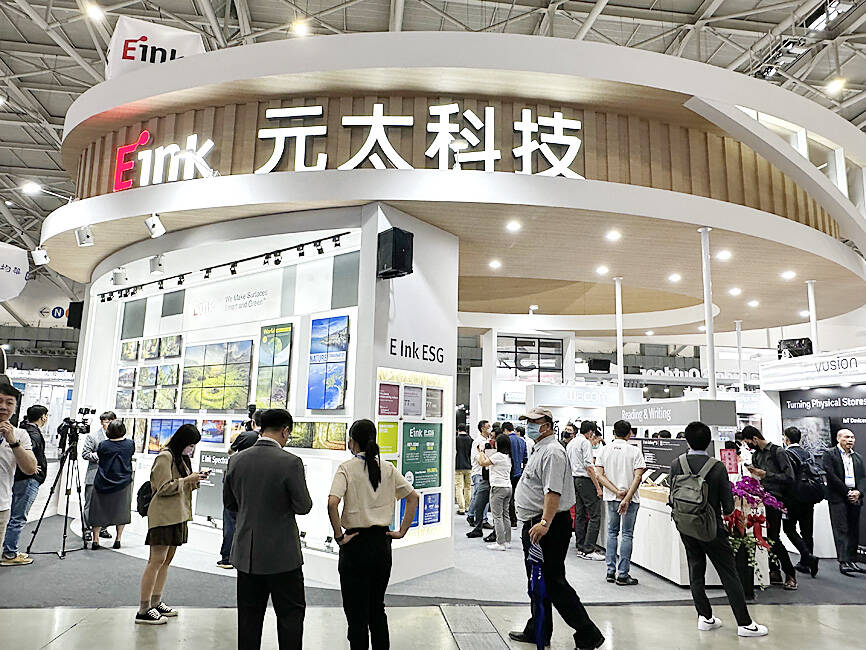E-paper display supplier E Ink Holdings Inc (元太科技) yesterday said its revenue growth is to recover this year as its customers rapidly adopt new four-color e-paper displays used in electronic shelf labels (ESLs).
Last year, customers’ inventory adjustments of previous-generation three-color e-paper displays slowed down their transition to new four-color e-paper displays for ESL and constrained E Ink’s revenue growth, the firm said.
The supply chain issue “is not a concern now,” E Ink chairman Johnson Lee (李政昊) told investors yesterday, adding that customers’ inventories are expected to return to a healthy level this quarter.

Photo: Chen Mei-ying, Taipei Times
In addition, the supply of driver ICs and display modules used in the new ESL displays are expected to improve this year, he said.
“The first quarter will be the trough for the ESL business, which will improve every quarter this year,” Lee said.
Feedback from its partners showed that about 80 percent of its customers plan to adopt four-color e-paper displays this year, compared with 20 percent in October last year, he said.
“Overall, the outlook for 2024 will be better than 2023,” Lee said. “Revenue this year will also be higher than last year, with the growth rate hinging on customers’ product transitions.”
E Ink posted revenue of NT$27.12 billion (US$861 million) for last year, down 9.78 percent from NT$30.06 billion in 2022.
In contrast to the clearer visibility for its ESL business, e-paper for consumer electronic applications — mostly e-readers and e-notes — are a “wild card” this year, Lee said, citing customers’ delayed launches of new models equipped with color displays instead of monochrome displays.
E Ink said its capacity expansion plans are on schedule, with the new production line in Hsinchu, dubbed H5, likely to enter volume production in the fourth quarter at the earliest to produce large-size e-paper displays measuring 85 inches to 95 inches (216cm to 241cm) for outdoor signages.
Another new production line, H6, is to enter operation in 2026 to manufacture even larger e-paper displays, the firm said.
The company has decided to restart its new plant construction in Taoyuan’s Guanyin District (觀音) this year, and is expanding module capacity at its Yangzhou plant in China for super-large e-paper displays from 75-inch to 100-inch displays, it said.
The Hsinchu-based company’s net profit fell 21 percent last year to NT$7.82 billion, from NT$9.91 billion a year earlier, and earnings per share dropped to NT$6.85, from NT$8.69.
Non-operating profit shrank 12 percent annually to NT$2.54 billion, attributable to a dip of 60 percent in royalty income, it said. Since 2019, E Ink has generated more operating income than the income from licensing its display patents, it added.
The firm’s board of directors last month approved a cash dividend distribution of NT$4.5 per share, with a payout ratio of 66 percent, up from 52 percent the previous year.

GROWING OWINGS: While Luxembourg and China swapped the top three spots, the US continued to be the largest exposure for Taiwan for the 41st consecutive quarter The US remained the largest debtor nation to Taiwan’s banking sector for the 41st consecutive quarter at the end of September, after local banks’ exposure to the US market rose more than 2 percent from three months earlier, the central bank said. Exposure to the US increased to US$198.896 billion, up US$4.026 billion, or 2.07 percent, from US$194.87 billion in the previous quarter, data released by the central bank showed on Friday. Of the increase, about US$1.4 billion came from banks’ investments in securitized products and interbank loans in the US, while another US$2.6 billion stemmed from trust assets, including mutual funds,

Micron Memory Taiwan Co (台灣美光), a subsidiary of US memorychip maker Micron Technology Inc, has been granted a NT$4.7 billion (US$149.5 million) subsidy under the Ministry of Economic Affairs A+ Corporate Innovation and R&D Enhancement program, the ministry said yesterday. The US memorychip maker’s program aims to back the development of high-performance and high-bandwidth memory chips with a total budget of NT$11.75 billion, the ministry said. Aside from the government funding, Micron is to inject the remaining investment of NT$7.06 billion as the company applied to participate the government’s Global Innovation Partnership Program to deepen technology cooperation, a ministry official told the

AI TALENT: No financial details were released about the deal, in which top Groq executives, including its CEO, would join Nvidia to help advance the technology Nvidia Corp has agreed to a licensing deal with artificial intelligence (AI) start-up Groq, furthering its investments in companies connected to the AI boom and gaining the right to add a new type of technology to its products. The world’s largest publicly traded company has paid for the right to use Groq’s technology and is to integrate its chip design into future products. Some of the start-up’s executives are leaving to join Nvidia to help with that effort, the companies said. Groq would continue as an independent company with a new chief executive, it said on Wednesday in a post on its Web

Taiwan Semiconductor Manufacturing Co (TSMC, 台積電), the world’s leading advanced chipmaker, officially began volume production of its 2-nanometer chips in the fourth quarter of this year, according to a recent update on the company’s Web site. The low-key announcement confirms that TSMC, the go-to chipmaker for artificial intelligence (AI) hardware providers Nvidia Corp and iPhone maker Apple Inc, met its original roadmap for the next-generation technology. Production is currently centered at Fab 22 in Kaohsiung, utilizing the company’s first-generation nanosheet transistor technology. The new architecture achieves “full-node strides in performance and power consumption,” TSMC said. The company described the 2nm process as